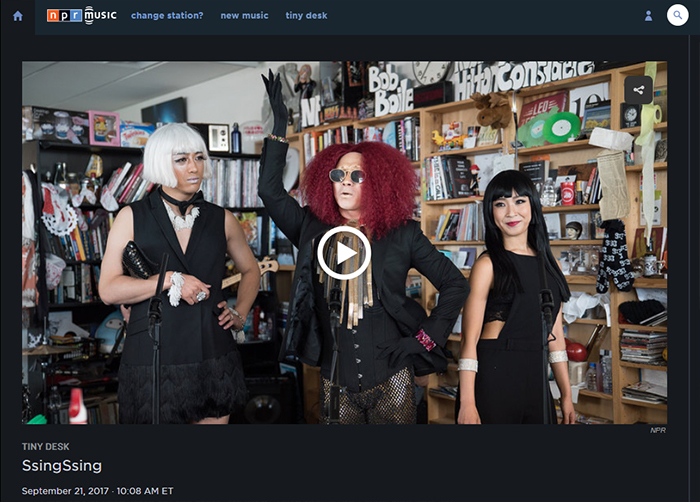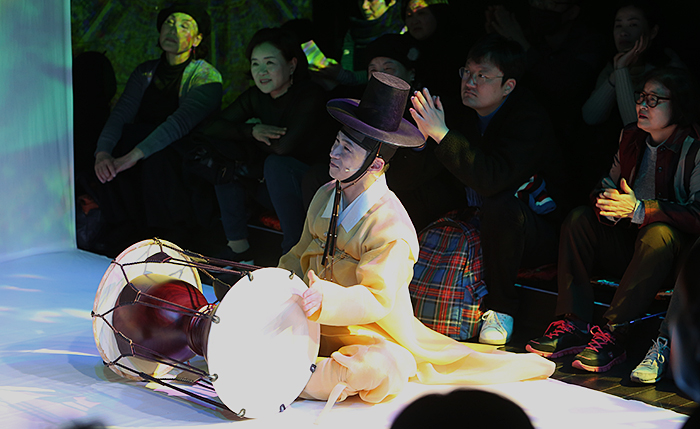
The Ssingssing Band, led by Gyeonggi Minyo master Lee Hee-moon (center), becomes the first Korean band to appear on the Tiny Desk Concert on U.S. public radio broadcaster NPR on Sept. 21. (captured image from the official NPR website)
By Xu Aiying and Sohn JiAe
Red-dyed hair. Leather jacket. Heavy makeup.
This is what singer Lee Hee-moon looks like. The singer is known for his signature style of Gyeonggi Minyo (경기민요) folk songs that have added to them Western elements from rock 'n' roll, jazz and funk.
Born to Gyeonggi Minyo master Ko Ju-rang, Lee joined the ranks of traditional gugak musicians in 2003 when he became one of the nation’s top gugak singers to have mastered the art of the Minyo songs from Gyeonggi-do Province.
In 2014, he formed with a six-member group called the Ssingssing Band (씽씽밴드), presenting on the global scene a modern version of the traditional folk music genre.
On Sept. 21 this year, his band appeared on the Tiny Desk Concert show on NPR, a well-known U.S. public radio broadcaster that highlights high-profile celebrities from around the world, such as Adele Adkins, John Legend and Cat Stevens. It was the first-ever appearance on the show by a Korean singer.
The Ssingssing Band's performance is on the station’s official YouTube channel and has been viewed more than 846,855 times, as of Nov. 23.
“I don’t stick only to traditions in music just because I’m a traditional singer. That's not that I live for in my own musical world. I explore various areas of music,” Lee said as he sat down with Korea.net on Nov. 17 in the Seochon neighborhood of northern Seoul.

Gyeonggi Minyo folk singer Lee Hee-moon presents his new songs in a way that uses aspects of modern art, including visual arts and designs, in the Seochon Space Seoro concert venue in Seochon, Seoul, on Nov. 17. (Seochon Space Seoro)
- You’ve sung Gyeonggi Minyo songs using various modern elements. What has been the reaction in the gugak world?
Gugak singers have a wholly different perspective than I do on the philosophy and traditions that they own in music. As my mother is also a traditional singer, I was also thusly inspired by traditional melodies from an early age; I had an indigenous stereotype that I must preserve the traditions. However, I’ve always been open to the various aspects that music can offer. That’s why I’ve been able to make countless approaches toward new music.
My philosophy is that our traditional music must live on and evolve at the same time. They shouldn’t remain as simply traditions. We should help the music survive by making a variety of changes to it.
- How have you seen non-Korean audiences react to your performances?
Their reaction is like, “My music is totally different from any Western music. It has its own distinctive charms.”
Whenever I listen to any Western pop music, I’m drawn first to its tune, not to what the lyrics say. Likewise, non-Korean listeners, too, can feel and understand my melodies even in Korean. For their better understanding, though, I tell them about what the lyrics are about.
- You recently unveiled your new song “Deep Sarangbang Love: Sagyechuk (Four Axes)" (깊은 사랑(舍廊)사랑: 사계축 (四契軸).” Tell us about the song.
It’s a combination of a traditional song, and then visual arts and design.
The song narrates the history of the Gyeonggi Minyo genre of folk songs. In a long winter break from farming, farmers used to dig deep into the ground and make a shack with rice straw as a place of rest. That's called a “Deep Sarangbang" (깊은 사랑방). The Sagyechuk was a pre-urban pathway spanning from the front of Seoul Station all the way through to Manri-dong in Jung-gu District and to Cheongpa-dong in Yongsan-gu District. Throughout the neighborhoods came numerous singers who are now well-received.
Currently, most Gyeonggi Minyo singers are female and I myself learned the song from a female singer, too. However, the traditions date back to male singers in their original. This new song sheds new light on such male singers.
- If you have any other challenges to take on, what would they be?
I want to do anything related to modern art, including acting and painting.
What I want to say to you, though, is no matter how I perform and no matter what method I use, my core lies in the Gyeonggi Minyo sound and in the gugak sound.
I’m scheduled to perform in Australia, the U.S. and Germany in February, March and April next year, too.
xuaiy@korea.kr
